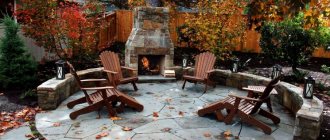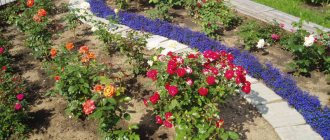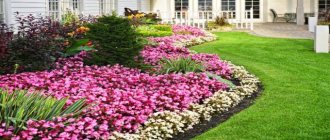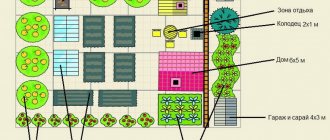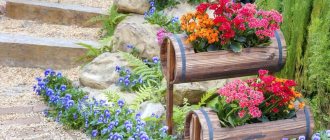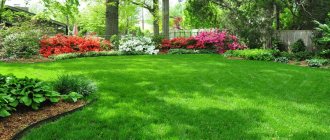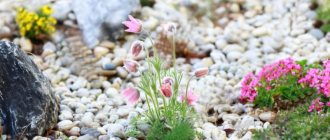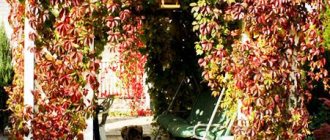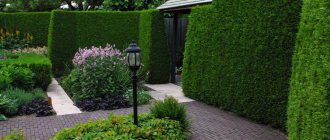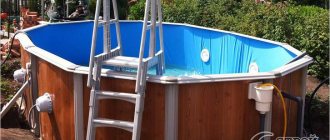Flower beds of continuous decorativeness delight with flowering throughout the entire gardening season
What is a mixborder? A mixborder is a fairly extensive flower garden with an irregular shape and free outlines. It includes a large number of perennial flowers, as well as low trees and shrubs. Most often, a mixborder is placed along a house, a fence, or surrounded by a lawn.
Most often, a mixborder is placed along a house, a fence, or surrounded by a lawn.
The main difference between a mixborder and other types of flower plantings is that it requires choosing plants that will provide your composition with stable decorativeness from spring to late autumn. Here it is important to correctly distribute the accents so that each time one or another group of plants takes the lead in the mixborder. If you select the wrong assortment, it may turn out that you get the peak of flowering in July-August, and in other months only green color will be present in your flower garden.
For a mixborder, it is necessary to select plants that will provide the composition with a stable decorative effect from spring to late autumn
The second mistake that gardeners often make in pursuit of continuous flowering is planting too many different types of plants , and even 1-2 of each. In this case, the plantings turn into a kind of vinaigrette. The color and outline of the plants merge into one shapeless spot, and all your efforts are reduced to zero.
In the right mixborder, something is constantly blooming; the plants do not merge into a single shapeless mass.
In order to avoid common mistakes, we suggest looking at 10 basic rules for creating a flower garden.
Rule 1
Assess the environmental conditions of the site .
This is the first place to start planning your plantings. To begin, try to determine as accurately as possible the type and structure of the soil on your site (dry, moist, sand, loam, etc.). Don't forget about soil acidity! Pay attention to another important condition - the lighting mode. Observe which part of the site has the most sun, how the shadow passes over it during the day, where there are shaded areas. If you can correctly assess the situation, you will definitely save your time and money, because plants planted in unsuitable environmental conditions will sooner or later die (or develop poorly). Assessing the environmental conditions of a site is the first place to start planning plantings. Buzulnik, astilbe, hosta, Rogers, and ferns are suitable for wet shade. Plants for dry sunny places: sedum, echinacea, angustifolia lavender, sage, catnip. Plants for acidic soils - rhododendron, azalea, heathers, cranberries, lingonberries.
Rule 2
Choose the style of the flower garden . Depending on the chosen style, you will create an assortment of plants. This rule is important to consider in order to create a harmonious composition that will fit perfectly into the garden space and help express your idea to the maximum .
There are many different styles and trends, among which several of the most common can be identified - natural, shady, rocky, English, romantic, country, Mediterranean, garden, etc. The range of plants in the flower garden depends on the chosen style. If you want to create a romantic flower garden, use plants in delicate colors, simple in appearance. Peonies, decorative onions, geraniums, speedwells, roses, sages, and bells are suitable for this. Stop your choice in shades of white, blue, pink and lilac. Such a flower garden will look especially impressive in light partial shade.
In a romantic flower garden, use plants in delicate colors that are simple in appearance.
Rule 3
Choose a color scheme , which largely depends on the style and location of the flower garden. The composition can be monochrome, that is, consist of plants of the same color . White, pink, yellow, blue are ideal for this. A mixborder can be very complex in color and consist of three or more shades of color . You can make a contrasting flower garden using only two colors. In any case, you need to remember the rule: the brighter your composition, the more neutral shades it should contain - green, white, silver. The composition can be monochrome, made in one color
Rule 4
Consider flowering times .
When you have worked through the first three points and selected suitable plants, make a flowering table. In the vertical column write all the plants in order, and in the upper horizontal column write the months, from April to November. Place a check mark at the intersection of the type of plant and the months in which it blooms (many bloom over several months). After filling out the entire table, you will immediately understand whether you have chosen the right assortment to ensure continuity of flowering or whether you should further refine the list. When creating a flower garden, be sure to take into account the timing of flowering plants. As a rule, the most difficulties arise with the selection of flowering plants for April-May and September-October. For early spring you can choose anemones, doronicums, primroses, mountain weeds, and aubrieta. To prolong autumn flowering, plant chrysanthemums, sedums, heleniums and perennial asters.
Stages of creation
When creating landscape design, different techniques and different landscaping elements are used. One of them is the arrangement of flower beds and flower beds. They are created by planting flowering plants. In this way, accent zones and bright spots are formed, which become a real decoration of the garden. In order for the described type of landscaping to look impressive, it is important to comply with all existing rules and regulations when creating it, and take into account the soil and climatic conditions of the area.
The arrangement of flower beds is carried out in five stages:
- First, the type of flower bed is determined.
- Then a project plan , and the flower bed is moved outside according to the created drawing.
- Then the plants are planted .
- It all ends with a long period of keeping and caring for the flowers.
An original view of organizing a flower garden Source yandex.ru
Choosing the type of flower bed
There are a large number of options for designing flower beds. Landscape compositions often use regular flower beds and flower beds of free configuration. The former differ from the latter in their strict geometric shapes and relatively small sizes. To create them, annuals and biennials, carpet-linear and potted-casing crops are often used. The second ones are filled with large spaces (from 80 m² and more). For these purposes, plants are used that, when flowering, help form one color. These could be tulips or chrysanthemums, phlox or peonies. Such plants retain their decorative properties throughout the entire growing season, when the buds fade and the texture and color of the leaves come to the fore.
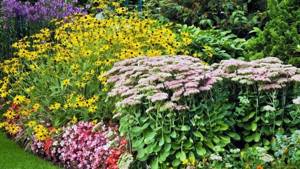
Flower garden of free configuration Source artfile.me
Flower beds with an area of 5 to 50 m² are called groups . They always have free outlines. The main emphasis is not the form, but the internal content. Sometimes simple groups are created by planting plants of the same crop. Complex groups are created from plants that bloom at different times of the season. In addition, gardeners use species of different heights to fill them. They place the highest ones in the center, and the lowest ones on the sides of the border. In this way volume is created.
- Mixborders are flower beds with an area of 3 to 5 m². They are formed by group planting of different plants, repeated at a specific interval. The shape of such a flowerbed can be different; inside it there may be flowers and beautiful cereal herbs. There are flat mixborders, volumetric and stepped. Such decorative elements always look very impressive: due to the presence of different types of plants, flower beds can bloom from spring to late autumn. Often, for additional decoration, mixborders use stone boulders, crushed stone, mulch, coarse sand, and any other bulk material.
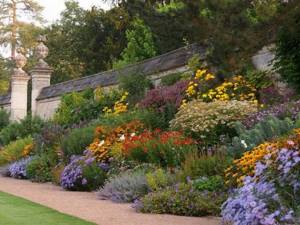
See also: Catalog of companies that specialize in landscaping work on sites.
- Tapeworms are flower beds that are organized in the middle of a green lawn, around a branchy tree, near the walls of a house. They are created by planting large-sized plants (rhubarb, peony, bocconia).
- Parterres are flower beds that are part of a regular composition. They often have a strict geometric shape, are always formed from decorative perennials and annuals, and have a clear contour-border. It can be made of different materials: made of brick, filled with concrete, lined with stone, or simply formed with a special plastic tape.
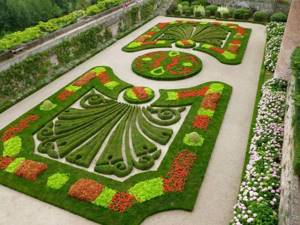
Parterre flower beds always have a strict geometric shape Source pinterest.co.kr
- Rabatki are flower beds that look like long rectangular ribbons. Their width varies from 50 cm to three meters. Such plantings are located along walking paths. They can be done as multi-row plantings of one type of plant or several.
- Borders are flower beds of a narrow elongated shape up to 50 cm wide. They are created as a border for other plantings and are used as a decoration for all of the above types of flower beds.
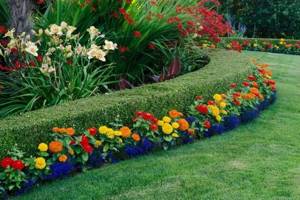
A bright border-ribbon framing a large element of the landscape composition Source pinterest.es
Development of a project plan - possible flower planting schemes
To make the arrangement and maintenance of flower beds possible, it is necessary to first draw up a clear plan for planting the plants, having first selected a seating scheme. There are a large number of possible combinations of plants in a flower bed. The easiest way is to make a monochrome flower garden. To create it, you need to choose flowers of the same shade and plant them in heaps in groups within the outlined boundaries.
If it is necessary to complicate the design, experts advise choosing plants of different heights. Plant the tallest ones (phloxes, for example) in the center. Around them are lower plants (meadow peoargonium), closer to the border are those that spread along the ground (pansies).
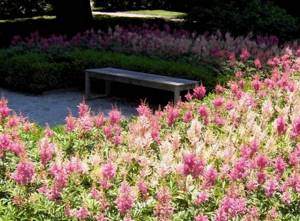
Monochrome round flower bed Source rozarii.ru
Rule 5
Don't forget about height and tiering. If you plan to create a composition with a one-way view, then the tallest plants can be planted in the background and gradually move on to shorter plants in the middle and foreground. If your planting will have a comprehensive, or all-round, view, then the tallest plants should be placed in the center. Important
: all planted plants should create a feeling of naturalness, each new group should appear from the volume of the previous one.
There is such a concept - “closed legs” .
So this is precisely the principle that must be used when planting. For example: we plant a monarda, in front of it is phlox, and in front of the phlox is catnip, which will lie in a spreading cloud on the lawn or path, covering the “legs” of the phlox. Conventionally, we can divide the entire range of plants into background, middle and foreground plants. The tallest (120-180 cm): sapling, New Belgian asters, delphinium, reed grass, veronicastrum, loosestrife.
The middle ground (50-100 cm) is the main assortment of garden flowers: echinacea, sage, speedwell, astilbe, phlox.
Conventionally, the entire range of garden crops can be divided into plants of the background, middle and foreground
And the foreground (20-40 cm) is the shortest species: mantle, heuchera, low-growing hostas and daylily, chickweed.
Foreground plants have a height of 20-40 cm
Ground cover plants do not take height into account, but they can be an excellent transition from a flower garden to a lawn or path. Plant thyme, awl-shaped phlox, sedum, carnation grass in the sun, and in the shade - tenacious, hoofweed or periwinkle.
Ground cover species help make a smoother transition from flower garden to lawn or path
Landscape: flowers in the foreground

Ancient church of Gospa od Angela (Bay of Kotor, Montenegro). In the background is the town of Perast and its main attractions: the island of St. George and the island of Gospa od Shkrpela. In the foreground are wildflowers.
We recently talked about photographing wildflowers close up, but today we'll talk about using them not as the main subject, but as the foreground in landscape photos.
The viewer enjoys being immersed in three-dimensional space when looking at a photograph. And three-dimensionality and volume in a photo can very easily be conveyed using a multi-dimensional composition. In addition, when there are several plans in the picture - meaningful elements that are different from us - the picture becomes more interesting and meaningful.
My photography teacher used to say that if theater begins with the coat rack, then landscape photography begins with the foreground.
Lupine flowers in a meadow (Moscow region).
In practice, it is more convenient to create multifaceted compositions with an interesting and expressive foreground using short-focus optics. Here you have a wide viewing angle, which allows you to capture more interesting fragments in the frame, and (all other things being equal) a greater depth of field. Such optics will provide the technical ability to make all shots sharp, even if the foreground is very close to the photographer.
In one of our lessons we talked about how to achieve maximum depth of field. During the shooting process, I used a Nikon AF-S 18-35mm f/3.5-4.5G ED Nikkor wide-angle zoom lens. It is perfect for both full-frame cameras (for example, Nikon D750 and Nikon D810) and cropped cameras (Nikon D3300 and Nikon D5500). However, on the latter it does not provide such a wide viewing angle, so for them we can recommend shorter focal length optics designed specifically for cropped lenses. For example, Nikon AF-S 10-24MM F/3.5-4.5G ED DX Nikkor lens.
If you photograph using longer focal length optics, the foreground will not always be included in sharpness. For example, like in this frame:
The shooting was carried out using a telephoto lens. Since the subject (night city) is very far away, and the foreground is close to the photographer, there was not enough depth of field for it.
NIKON D810 / 70.0-200.0 mm f/4.0 SETTINGS: ISO 31, F11, 30 s, 86.0 mm equiv.
Will this make the frame look much worse? Not necessary. The foreground doesn't always have to be sharp. Sometimes it is enough for it to have recognizable outlines. Experiment with foreground sharpness in your own photos and try different options.
Foggy morning on the banks of the Oka (Kaluga region).
Don't miss the flowering time! Late spring and early summer are great times for photography. At this time, flowers can be found everywhere. Try to preserve the beauty of nature in your photos!
Rule 6
Think about the structure. This is an important component of any garden composition, including a flower garden. It is necessary to create a “skeleton”, the basis of the plantings. Perennial plants that are stable from spring to autumn are suitable for these purposes. This means that they form a dense bush, do not fall apart , and after flowering do not lose their decorative effect. Structural plants can “support” their neighbors, or cover temporarily formed voids after trimming some flowers (delphinium, oriental poppy, lupine) until they form a new rosette of leaves. Skeletal plants include peony, bearded iris, etc. Siberian, astilbe, hosta, daylily. Perennials, which are stable from spring to autumn, make up the main structure of the flower garden.
The most beautiful flower beds - geometry of color and elegance of shapes
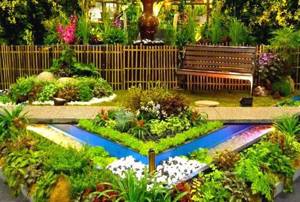
A triangular flowerbed adjacent to the path in the recreation area. Flowers are planted in several parallel lines. The blue plastic involved in the composition creates the illusion of a water surface. The effectiveness of flowerbeds of this type can be increased by placing them on both sides of the path opposite each other.
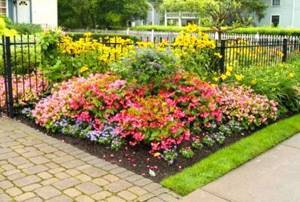
A high corner flower bed is good at the entrance to the site
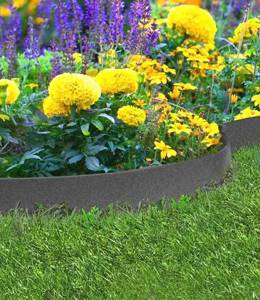
Several flower beds in the shape of perfect circles - and the lawn looks especially stylish. For the flowerbeds of a small lawn, choose low flowers and a simple border - for example, a border strip.
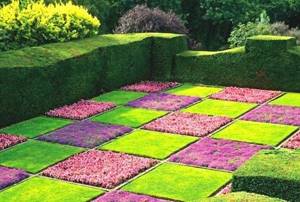
A checkerboard lawn with green squares (lawn grass) alternating in a certain order and square-shaped flowerbeds with low, possibly ground cover plants.
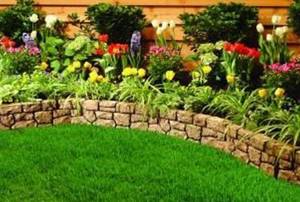
A concave border, made of decorative stone or brick, organizes a flower garden with different plants and visually expands the area. We plant low plants in the foreground of the flowerbed framing the lawn, and medium-tall or tall ones in the background.
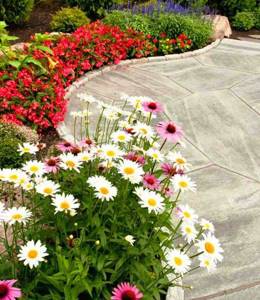
This flower bed can also be called a border bed or flower border. A strict platform made of slabs or stone and bright flowers are a good combination.
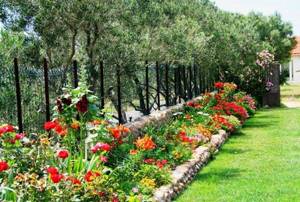
The stone fence of the area along which the flower bed is arranged supports a low border of the same material.
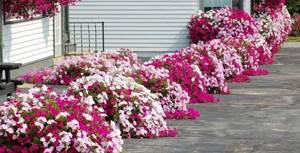
When paving the area, provide areas free of tiles or stones for small flower beds. These can be mono-flower beds from plants of the same species and color.
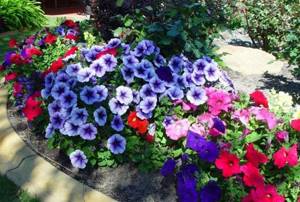
Plants along the path - one type, different colors
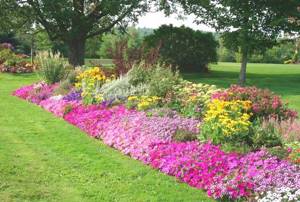
Large elongated flower bed with different plants
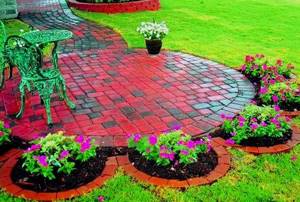
Flower beds around a platform paved with paving stones. Original flower border
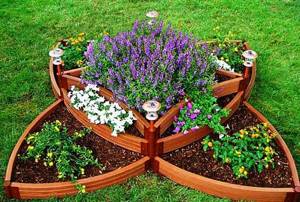
An interesting three-tiered floral design created using a prefabricated plastic border
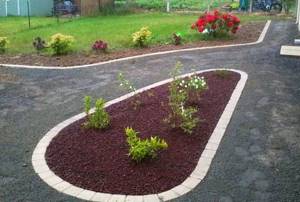
A flower bed in the shape of an elongated drop is built into the paving slabs.
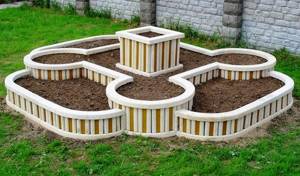
The design is original - a complex of flower beds. Allows you to create flower beds of any shape, including multi-level ones.
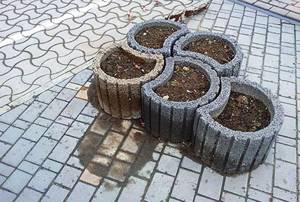
Outdoor containers for plants, from which you can make flower beds of any size and shape with your own hands.
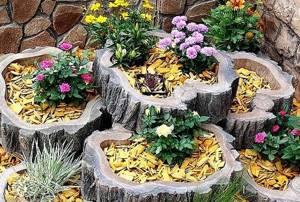
For multi-level flower beds we use bark from cuttings of large trees. Impressive composite beds without the expense of planting containers.
Rule 7
Plant trees and shrubs. Another distinctive feature of the mixborder is the ability to include low (3-5 m) trees and shrubs. Trees must be selected taking into account their decorative qualities (flowering, bark color, color and shape of leaves). Some shrubs can be formed in the form of small trees on a trunk (lilac, viburnum, mock orange). And you can choose species and varieties that go well with perennials - hydrangea, cinquefoil, weigela, spirea. Based on the idea of the composition, decide whether you will shape (cut) the plants or leave them free. Mixborders often include low trees and ornamental shrubs
Rule 8
Include bulbous plants in the composition. Taking into account the different flowering times, you can plan their flowering from spring to autumn. In early spring you will be pleased with crocuses, pushkinias, chionodoxa, and scilla. Tulips, daffodils, hazel grouse and hyacinths, depending on the type and variety, bloom from May to June. In June, the accent will be various decorative bows, in the middle and end of summer - lilies and gladioli. Crocosmia and crocus bloom in autumn. Bulbs need to be planted in large groups side by side so that there is a feeling of a bouquet, a large spot of color
Flower garden: background plants
Helleniums were considered autumn plants; their flowering began in August. Now there are new varieties that bloom in early July. They are also distinguished by their small stem height: the red varieties 'Rubinzwerg' and 'Ruby Tuesday', the yellow 'Wyndley' with a height of only 40–50 cm, the semi-double variety 'Double Trouble' - 80 cm. Helleniums grow well in full sun and are able to tolerate light drought.
Leucanthemum maximum is native to Western Europe. Its large white daisies bloom in both shade and sun. This species has many varieties, among them - with semi-double and double baskets ('Fiona Coghill', 'Sunny Side Up'). New items are varieties with cream and yellow colored marginal petals ('Goldrausch', 'Sonnenschein'). The height of the stems varies greatly among different varieties: meter-long 'Becky' and small varieties, for example 'Silberprincessin' (25 cm). Low-growing ones will decorate borders and the first plans of flower beds, tall ones will emphasize the brightness of red, scarlet and set off the yellow-orange tones of roses.
Purple coneflower (Echinacea purpurea), an American plant, has appeared in our gardens relatively recently, but its strong stems with rough matte leaves and bright, elastic large “daisies” have already become a favorite among gardeners. Echinacea purpurea has many varieties, they vary in height: from 30 cm for 'Little Giant' and 'Kimm's Moped' to 100 cm for 'Vintage Wine'. And to the various shades of pink-purple have now been added varieties with pure white ('White Swan'), lemon ('Sunrise'), orange ('Harvest Moon') flower petals, the double variety 'Razzmatazz' and the variegated 'Sparkler'.
New items include western rudbeckia (Rudbeckia occidentalis) variety 'Black Beauty', which is close to coneflowers, 120–130 cm high, with baskets of edgeless petals. Its black conical inflorescences on branched bare stems look very original.
Echinacea and rudbeckia develop well in the hottest place, and grow well in partial shade.
Many types of bluebells bloom in July, among them the broadleaf bluebell (Campanula latifolia). This mid-latitude plant is very unpretentious and thrives in our gardens: it grows powerful and tall – almost up to two meters. Its huge flowers, up to 8 cm long - lilac, lilac, white - form a dense one-sided raceme 60–70 cm long. Powerful bushes of broadleaf bellflower require a garter. This bellflower is a wonderful background plant. Its purple and lilac forms harmonize with both red and yellow tones. They are also magnificent next to white and cream lilies.
The crowded bellflower (Campanula glomerata) is also very unpretentious. In the nature of the middle zone, it can be found in wastelands and wastelands. But it is also good in the garden. Medium-growing varieties such as 'Superba' and 'Emerald', 30–40 cm high, can create a bright purple spot in a flower garden. Lower ones, such as 'Acaulis', make excellent foreground border plants. These bells look very Russian next to low grasses - fescue (Festuca) or golden butler (Alopecurus pratensis).
Up to 1m high, Campanula trachelium cultivar 'Bernice' is a stunning new arrival . Dense inky color, double flowers... Moreover, it does not “scatter” around the garden like other bells.
Blue onion (Allium caerulleum) is one of the most beautiful among ornamental onions. Its flowering begins at the end of June and continues until the beginning of August. The bright blue balls of this onion, 8–9 cm in diameter, rise above the flower garden on straight bare peduncles up to 1 m high. It is very noticeable: such a pure blue color is rarely seen in a summer garden. At the same time, onions are very unpretentious and take up practically no space; the bulbs can be planted between other perennials.
Fluffy Liatris spicata , available in purple, pink or white, fit easily into any flower garden. They grow well in moderately moist soil in both partial shade and sun. To the well-known varieties 'Alba' and 'Kobold' were added new 'Floristan Violet' and 'Floristan White' with a height of 75 cm and a small 'Kobold Original' with a height of up to 35 cm. The uniqueness of this plant is that the flowers begin to open from the upper end of the inflorescence, which allows you to cut off the faded tip, and the plant does not lose its decorative effect for a long time.
Lily of the valley (Lisimachia cletroides) is very beautiful, but it “runs away” quite strongly. When planting, it is necessary to limit it by placing it in a container with a capacity of at least 10 liters. Curved spike-shaped racemes, studded with white flowers, are very graceful. This loosestrife does not like open sun; its favorite place is partial shade.
No garden is complete without the Turkish clove (Dianthus barbata). This is a long and abundantly flowering plant. It is considered a juvenile, but this is not entirely true: by planting basal rosettes, it is possible to prolong the life of the plant. Of course, you will want to do this if you sow terry, low-growing bearded carnations (height less than 20 cm) and see them bloom. New arrivals include the variety 'Sooty' with dark purple leaves and almost black velvety flowers.
Astrantia maxima has long been introduced into horticultural culture. An amazing plant from the umbrella family. What we take for an astrantia flower is actually an inflorescence: the beautiful leaves of the bract form a kind of “collar” above it - a mass of small flowers on pedicels 2–2.5 cm long. Now varieties have appeared ('Mulen Rouge', 'Roma' , 'Claret'), in which the bracts and pedicels are beautifully colored in pink-purple tones. Small flowers appear in late June - early July, and then small, very cute boxes are formed.
It seems that astrantia blooms throughout July, since the bract does not lose its bright color. To successfully grow large astrantia, the main thing is that the soil is moderately moist throughout the season. That is, if the soil on the site is clayey and moisture-absorbing, then astrantia can be planted in the sun; if, on the contrary, it is porous, easily releasing moisture, the place of astrantia is in partial shade.
Discreet astrantia bushes evoke a feeling of amazing lightness and airiness. They are very appropriate around heavy lilies, daylilies and short roses with large flowers.
Not the last place in the July garden is given to cereals , sedges and rush plants . Green, blue, yellow, variegated, they fit quite easily into the garden design.
For example, a very unpretentious reed grass (Calamagrostis acutif lora) of the 'Overdam' variety with white-green leaves. A sheaf of reed grass 1–1.2 m high is elegant and stable. It can be included in various compositions or used as a vertical.
Gray's sedge (Carex greiji) does not like hot sun, but grows in shade and partial shade without much trouble. A bush up to 50 cm high does not require garter. This sedge blooms in early June, and in July it is already decorated with club-shaped fruits.
Rule 9
Complete the flower garden with annuals . If the garden is still young and there is a lot of free space between plantings, feel free to fill it with annual flowers. Choose plants that suit your style. They will help create the feeling of a complete, mature garden. And if you have planned a monochrome flower garden, then annuals will be an excellent addition to the existing plants and will maintain the desired color for a long time. Antirrinum, cleome, zinnia, and scabiosa are suitable for these purposes. For the foreground you can use purslane, verbena, and eschscholzia. Free space in a young garden can be filled with annual plants
Rule 10
Take care of your plants. In order for your compositions to always be healthy and look good, they need timely care. Remove faded inflorescences in a timely manner against diseases and pests.
Purchase the necessary medications in a timely manner and carefully monitor your plants. Most importantly, don’t forget to take pictures of your garden! It changes throughout the season and becomes even more beautiful from year to year. Capture these moments in the life of your garden and enjoy the results of your labor. We remind you that there will be no homework in all Landscape Design School lessons. However, there is no need to relax! At the end of the training course, you will be tested for knowledge - a final exam on all topics.
You can purchase plants for creating flower beds and mixborders at the nursery of Agroholding POISK.
- Trees and shrubs : hydrangeas, weigelas, cinquefoils, spirea, rhododendrons and others.
- Perennial flowers : saplings, loosestrife, hostas, coneflowers, speedwells, astilbes, daylilies, peonies, irises, heucheras, ornamental grasses and others.
- Annual flowers : cleomes, zinnias, scabiosa, purslane, verbena, eschscholzia.
- Bulbous : tulips, daffodils, hazel grouse, hyacinths, scillas, crocuses, lilies, gladioli, colchicums, chionodoxes, pushkinias.
- Ground cover plants : thyme, herbaceous carnation, periwinkle.
Creative ideas for creating a flower garden
By placing a large pot with a soil mixture inside on its side, they create a flower stream by planting plants starting directly from the neck. A curved line looks especially impressive.
If there is a small pond on the site, fix miniature pots with flowering plants on foam plastic and lower them into the water. Such floating flower beds add a romantic touch to the surrounding atmosphere.
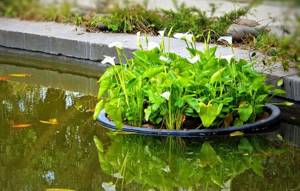
Floating flower bed
An original flower pole is created from a chain-link mesh rolled into a cylinder shape. They fasten it with wire, cover the internal space with agrofibre and fill it with soil. Ampelous varieties of flowers are planted in the cuts cut on the side walls.
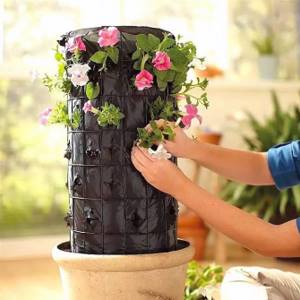
A flowerbed made by yourself will become the pride and decoration of your site
The activity of creating flower beds yourself becomes exciting and fruitful if you approach it creatively and systematically. Introducing your own ideas into ready-made solutions makes any version of flower beds unique and original.
Author of the article: Lastovskaya Lyudmila Viktorovna
Tags: flower beds
- Related Posts
- 38 of the most unpretentious long-flowering perennials for growing in country flower beds
- Valerian will help against cabbage pests: tested by myself
- Roses - how to grow on your own plot: planting, pruning, care, diseases and pests
« Previous entry

